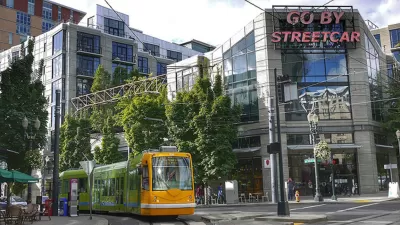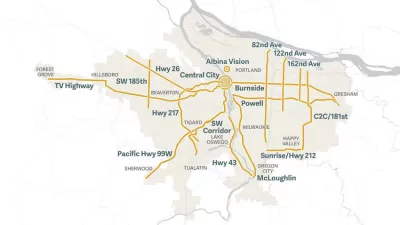As a nation, we are driving less, but we are increasingly stuck in traffic. What explains this paradox? Using Portland as an example, where driving peaked in 2004, Joseph Rose attempts to explain with lots of help from transportation experts.
In short, motorists are "primarily getting behind the wheel only when we have to -- like getting to and from jobs at the same time as everybody else" which means that some roads do indeed experience congestion, writes Rose.
"It's really difficult for some people to their get arms around this," said Micheline Maynard, a former Detroit bureau chief for The New York Times and author of the coming book "Curbing Cars: Rethinking How We Get Around." "I'm stuck in a traffic jam and I can't get where I need to go, yet you're telling me driving is down. Well, there's an explanation."
Short suggests that "Americans appear to be modifying their automotive priorities for environmental, social and economic reasons."
"They're certainly not becoming anti-car," said Jackie Douglas, executive director of the Boston-based alternative-transportation advocacy group LivableStreets Alliance and the person widely credited with coining the term "driving light." "But with the cost of driving, along with tightening budgets and changing attitudes, more households are realizing they don't need to drive everywhere and they don't need a car for every family member who can drive."
In addition, The Car Connection's Richard Read writes that many cited "studies both focused on the number of miles traveled per person and per vehicle. For example, Michael Sivak of the University of Michigan Transportation Research Institute determined that the average American vehicle traveled 11,318 miles in 2011, down from 11,946 in 2004. [However, Sivak also studied vehicle ownership. See a June post on this study].
However, the number of vehicles on the road continues to increase, thanks to business growth, population growth, and other factors. So, yes, we're driving less, but there are more of us driving. That means a net gain of cars on the road, which means an increase in traffic.
Rose provides interesting data on car ownership in the Portland region, where the reduction in car ownership is not uniform. In Washington County, since 2002, the population "surged 16 percent to 547,672 and the number of registered passenger vehicles is up 14 percent to 418,265, suggesting that development patterns, industrial expansion and TriMet cuts in the fast-growing county have left it as car-dependent as ever."
But in Multnomah County, as bicycle commuting, car sharing and transit use has transpired at a revolutionary pace, the number of registered vehicles grew by less than 1 percent, even as the population grew by 11 percent.
"Joseph Rose is The Oregonian's commuting and transportation writer, covering the science and culture of traffic, transit and bicycling in Portland, Oregon."
FULL STORY: Driving drops, but Portland gridlock among the tops: What gives? It's called 'driving light'

Alabama: Trump Terminates Settlements for Black Communities Harmed By Raw Sewage
Trump deemed the landmark civil rights agreement “illegal DEI and environmental justice policy.”

Study: Maui’s Plan to Convert Vacation Rentals to Long-Term Housing Could Cause Nearly $1 Billion Economic Loss
The plan would reduce visitor accommodation by 25% resulting in 1,900 jobs lost.

Planetizen Federal Action Tracker
A weekly monitor of how Trump’s orders and actions are impacting planners and planning in America.

Wind Energy on the Rise Despite Federal Policy Reversal
The Trump administration is revoking federal support for renewable energy, but demand for new projects continues unabated.

Passengers Flock to Caltrain After Electrification
The new electric trains are running faster and more reliably, leading to strong ridership growth on the Bay Area rail system.

Texas Churches Rally Behind ‘Yes in God’s Back Yard’ Legislation
Religious leaders want the state to reduce zoning regulations to streamline leasing church-owned land to housing developers.
Urban Design for Planners 1: Software Tools
This six-course series explores essential urban design concepts using open source software and equips planners with the tools they need to participate fully in the urban design process.
Planning for Universal Design
Learn the tools for implementing Universal Design in planning regulations.
Caltrans
Smith Gee Studio
Institute for Housing and Urban Development Studies (IHS)
City of Grandview
Harvard GSD Executive Education
Toledo-Lucas County Plan Commissions
Salt Lake City
NYU Wagner Graduate School of Public Service





























